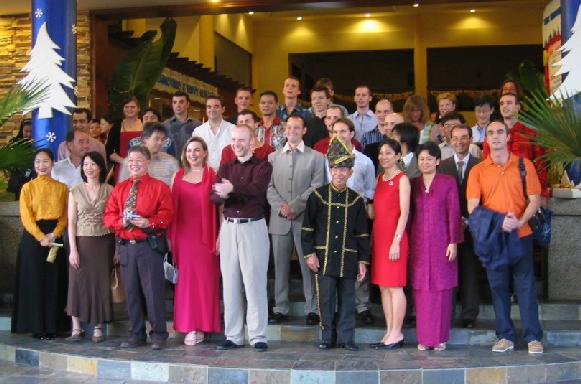DEFINITIVE RECOVERY FROM A HITHERTO NON-CURABLE DISEASE CALLED ENDOMETRIOSIS
Teacher, Writer, Composer, Musician, Shaolin Wahnam Instructor, Toronto, Canada

Emiko Hsuen (far left) with brothers and sisters of the international Shaolin Wahnam Family during the wedding celebrations of Sifu Wong's eldest daughter in Malaysia in December 2004
A Brief Review of My Medical (Personal) History
- In 1995, I was diagnosed with a debilitating disease called Endometriosis.
- On October 6, 1995, I had laparoscopic surgery and was post-operatively diagnosed as having Stage III Endometriosis and Uterine Fibroids.
- In October 2000, blood tests revealed that I was also suffering from Hypothyroidism.
- All three chronic disorders are considered incurable by western medicine.
- In December 2000, I flew to Malaysia and learnt Shaolin Cosmos Chi Kung and Shaolin Kungfu from world-renowned Grandmaster Wong Kiew Kit. I was told that if I practiced exactly in the manner in which I had been instructed, without fail, that I would be cured of Endometriosis within one year (by December 2001).
- I believed him and did the practice exactly as I was told.
- In February 2001, blood tests revealed that I no longer had Hypothyroidism.
- In July 2001, the symptoms of Endometriosis completely disappeared.
- In September 2003, ultrasound reports showed that the Uterine Fibroids had grown. I was booked for surgery at the end of January 2004.
- In October 2003, I flew down to Boston to learn about Macrobiotics.
- I began to incorporate more chi kung principles into the diet.
- The diet and chi kung proved to have beneficial effects: in subsequent ultrasounds there was little or no growth of the fibroids.
- Due to my lifestyle and certain extenuating circumstances, I was not able to maintain the diet. The fibroids began to grow again at a rapid rate.
- On April 20, 2005, I underwent a full laparotomy and had all of the fibroids removed (14 in total).
- Post-surgery, I was informed by the surgeon and other attending doctors that during the surgery, search as they might, they had been unable to find the presence of Endometriosis. Though I had not suffered any pain since July 2001, it was expected that scar tissue and remains of the disease would still be visible. Apparently, there was not a trace of it any where.
- I am now an authentic “case study” showing irrefutable evidence that a person can be fully cured from Endometriosis (as opposed to an anecdotal story). This may be the first time ever that doctors now have evidence to show Endometriosis is a curable disease.
- This ground-breaking news has already been communicated by a doctor to the President of the World Endometriosis Association (Milwaukee). It is also being communicated to the Director of the Japanese Endometriosis Association.
Endometriosis
(The following subsections are all quoted from an informative text called Coping with Endometriosis by Robert H. Phillips, Ph.D., and Glenda Motta, R.N.)
What is Endometriosis?
“Endometriosis is one of the most prevalent gynecological disorders, affecting millions of women and girls around the world. The incidence of endometriosis diagnoses is on the rise, and we can no longer afford to treat the disease as an insignificant issue.
Endometriosis can result in incapacitating pain, infertility, and repeated surgeries, and can render a woman or girl unable to go about her normal routine. This disease affects not only the patient, but also everyone around her. Dr. Von Rokitansky first detailed the disease in 1860.” (xiii)
"Endometriosis is a chronic disease of a woman's or teenage girl's reproductive and immune systems. Patches of endometrial tissue — similar to the tissue normally found only in the endometrium, the lining of the uterus — grow outside the uterus (the womb). This tissue develops into different types of "growths", also called "implants," "nodules,” or "cysts," which can cause pain, bleeding, infertility, problems with your bowel or bladder, many other symptoms or changes." (4)
"Endometriosis affects women and teenage girls of all races all over the world. Endometrial tissue has been found in autopsies of infants, premenstrual adolescents, posthysterectomy, and postmenopausal women (even in five men!), but generally occurs in women who are having menstrual periods?age at diagnosis ranges from the midteens to the forties.
One study reported that more than 50% of teenage girls undergoing surgery for severe pelvic pain had lesions. The Endometriosis Association and the Endometriosis Research Centre estimate that 2-4% of the general female population worldwide may have endometriosis.
Endometriosis affects more women than breast cancer. The average delay from the beginning of symptoms to diagnosis of the disease is over nine years. The disease is often confused with pelvic inflammatory disease, bladder infections, irritable bowel syndrome, and a multitude of other conditions. This means millions of women and girls suffer needlessly and treatment is delayed.” (6)

Emiko Hsuen, an instructor os Shaolin Wahnam Canada, posing at the Golden Bridge stance
What causes Endometriosis?
"Despite the number of theories as to the cause of endometriosis, none seem to account for all cases." (8)
What are the symptoms of Endometriosis?
"For the most part the symptoms of endometriosis can be divided into the following main categories: pain, fatigue, bowel and bladder complications, heavy or irregular bleeding, and fertility problems." (12)
"In addition?women with endometriosis can experience dizziness, migraine headaches, low back pain, poor resistance to infections, extensive allergies, chemical sensitivities, vaginal discharge between periods, yeast infections, and low-grade fever." (15)
What are the stages of Endometriosis?
"Stage II is mild. There is deep endometriosis in the peritoneum and both ovaries have superficial involvement.
"Stage III is moderate. There can be superficial or deep endometriosis in the peritoneum. The cul-de-sac (the area between the wall of the uterus and the rectum) is involved. Lesions are deep in one ovary, and the fallopian tubes are often affected. Adhesions are deep.
"Stage IV is severe. The number and type of implants are large; there are dense adhesions in the peritoneum, the fallopian tubes, and the ovaries. Often, there is extensive scar tissue. There is considerable disease in many locations such as the ovaries, fallopian tubes, bladder, bowel, appendix, peritoneum, and cul-de-sac.
"The staging system? is flawed in that the staging is not related to pain. (In some women, lesions may be small but cause severe pain. Others may have large lesions without a lot of pain.) It also does not label the changes that may be going on in the immune system and does not allow for the fact that implants may fluctuate in size." (20)
What is the Prognosis of Western Medical Experts?
"Endometriosis is a chronic disease with no cure at the present time, which means that it can last as long as you are alive. New data from the world's largest research registry on endometriosis show that women with endometriosis and their families have a heightened risk of breast cancer, melanoma, and ovarian cancer.
There is also a greater risk of non-Hodgkins lymphoma in these families and a significantly higher incidence of diabetes, thyroid disorders, and other autoimmune diseases such as rheumatoid arthritis, lupus, multiple sclerosis, and M?ni?re's disease?.Serious problems with endometriosis occur when it has a destructive effect on important internal organs." (20)
Medical Findings — Irrefutable Evidence that Endometriosis is a Curable Disease
Report 1 — Diagnosed with Endometriosis
Location: North York Branson Hospital
Service Date: Oct. 6, 1995
Quoted from Inpatient Operative Report:
"It was apparent that there was hemochromatic material scattered throughout the pelvis. There was a cystic structure on the left ovary. Foci of endometriosis was seen on the right ovary and also in the pouch of Douglas.
The area was irrigated and we then grasped the ovary and incised through the cortex attempting to find a plane whereby we could remove the cyst, however, we ruptured into the cyst and it began to leak chocolate material. We irrigated and flushed this area clean?and amputated the cystic portion of the ovary leaving behind a good third to half of normal ovarian tissue on the left side.
"We coagulated the foci of endometriosis on the right ovary and also a few independent foci seen throughout the pelvic basin but there was a lot of brownish golden staining over the bladder peritoneum from presumed leakage of this endometrioma?Final Diagnosis: 1. Endometrioma, left ovary 2. Disseminated Endometriosis (This would be Stage 3 endometriosis)."
Report 2 -- Diagnosed without Endometriosis
Location: Sunnybrook & Women's College, Health Sciences Centre, Women's College Campus
Service Date: Apr. 20, 2005
Quoted from Inpatient Operative Report:
"Examination revealed normal tubes and ovaries. There was no evidence of endometriosis in the cul de sacs, ovaries or other areas?"
Quoted from Surgical Pathology Consultation Report:
"Diagnosis: Tissue from uterus: - uterine leiomyoma (see comment)? Comment: Multiple sections are examined?These show the presence of a leiomyoma which shows no significant abnormality microscopically?the case would still be regarded as clearly benign with no potential for malignant activity."
N.B. Had there been endometrial tissue present, the pathology report would have included this information in its findings. The fact that the doctor only makes mention of the myomas (fibroids) is further proof of the fact that the endometriosis is completely gone.
